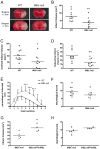Genetically-defined deficiency of mannose-binding lectin is associated with protection after experimental stroke in mice and outcome in human stroke
- PMID: 20140243
- PMCID: PMC2815773
- DOI: 10.1371/journal.pone.0008433
Genetically-defined deficiency of mannose-binding lectin is associated with protection after experimental stroke in mice and outcome in human stroke
Abstract
Background: The complement system is a major effector of innate immunity that has been involved in stroke brain damage. Complement activation occurs through the classical, alternative and lectin pathways. The latter is initiated by mannose-binding lectin (MBL) and MBL-associated serine proteases (MASPs). Here we investigated whether the lectin pathway contributes to stroke outcome in mice and humans.
Methodology/principal findings: Focal cerebral ischemia/reperfusion in MBL-null mice induced smaller infarctions, better functional outcome, and diminished C3 deposition and neutrophil infiltration than in wild-type mice. Accordingly, reconstitution of MBL-null mice with recombinant human MBL (rhMBL) enhanced brain damage. In order to investigate the clinical relevance of these experimental observations, a study of MBL2 and MASP-2 gene polymorphism rendering the lectin pathway dysfunctional was performed in 135 stroke patients. In logistic regression adjusted for age, gender and initial stroke severity, unfavourable outcome at 3 months was associated with MBL-sufficient genotype (OR 10.85, p = 0.008) and circulating MBL levels (OR 1.29, p = 0.04). Individuals carrying MBL-low genotypes (17.8%) had lower C3, C4, and CRP levels, and the proinflammatory cytokine profile was attenuated versus MBL-sufficient genotypes.
Conclusions/significance: In conclusion, genetically defined MBL-deficiency is associated with a better outcome after acute stroke in mice and humans.
Conflict of interest statement
Figures






Similar articles
-
Mannose-binding lectin (MBL)-associated serine protease (MASP)-1 contributes to activation of the lectin complement pathway.J Immunol. 2008 May 1;180(9):6132-8. doi: 10.4049/jimmunol.180.9.6132. J Immunol. 2008. PMID: 18424734
-
Enhancement of complement activation and opsonophagocytosis by complexes of mannose-binding lectin with mannose-binding lectin-associated serine protease after binding to Staphylococcus aureus.J Immunol. 2002 Oct 15;169(8):4430-6. doi: 10.4049/jimmunol.169.8.4430. J Immunol. 2002. PMID: 12370377
-
Mannose-binding lectin and mannose-binding lectin-associated serine protease 2 in susceptibility, severity, and outcome of pneumonia in adults.J Allergy Clin Immunol. 2008 Aug;122(2):368-74, 374.e1-2. doi: 10.1016/j.jaci.2008.05.037. Epub 2008 Jun 25. J Allergy Clin Immunol. 2008. PMID: 18582923
-
The emerging roles of mannose-binding lectin-associated serine proteases (MASPs) in the lectin pathway of complement and beyond.Immunol Rev. 2016 Nov;274(1):98-111. doi: 10.1111/imr.12460. Immunol Rev. 2016. PMID: 27782318 Review.
-
Structural and functional overview of the lectin complement pathway: its molecular basis and physiological implication.Arch Immunol Ther Exp (Warsz). 2013 Aug;61(4):273-83. doi: 10.1007/s00005-013-0229-y. Epub 2013 Apr 7. Arch Immunol Ther Exp (Warsz). 2013. PMID: 23563865 Review.
Cited by
-
Mannan-binding lectin in cerebrospinal fluid: a leptomeningeal protein.Fluids Barriers CNS. 2012 Aug 13;9(1):17. doi: 10.1186/2045-8118-9-17. Fluids Barriers CNS. 2012. PMID: 22889364 Free PMC article.
-
The central role of peripheral inflammation in ischemic stroke.J Cereb Blood Flow Metab. 2023 May;43(5):622-641. doi: 10.1177/0271678X221149509. Epub 2023 Jan 5. J Cereb Blood Flow Metab. 2023. PMID: 36601776 Free PMC article. Review.
-
The good, the bad, and the opportunities of the complement system in neurodegenerative disease.J Neuroinflammation. 2020 Nov 25;17(1):354. doi: 10.1186/s12974-020-02024-8. J Neuroinflammation. 2020. PMID: 33239010 Free PMC article. Review.
-
Pathogenic natural antibodies propagate cerebral injury following ischemic stroke in mice.J Immunol. 2012 Feb 1;188(3):1460-8. doi: 10.4049/jimmunol.1102132. Epub 2011 Dec 23. J Immunol. 2012. PMID: 22198950 Free PMC article.
-
The alternative complement pathway propagates inflammation and injury in murine ischemic stroke.J Immunol. 2012 Nov 1;189(9):4640-7. doi: 10.4049/jimmunol.1201904. Epub 2012 Oct 1. J Immunol. 2012. PMID: 23028050 Free PMC article.
References
-
- Carroll MC, Holers VM. Innate autoimmunity. Adv Immunol. 2005;86:37–57. - PubMed
-
- van Beek J, Elward K, Gasque P. Activation of complement in the central nervous system: roles in neurodegeneration and neuroprotection. Ann N Y Acad Sci. 2003;992:56–71. - PubMed
-
- Mocco J, Wilson DA, Komotar RJ, Sughrue ME, Coates K, et al. Alterations in plasma complement levels after human ischemic stroke. Neurosurgery. 2006;59:28–33. - PubMed
-
- Lindsberg PJ, Ohman J, Lehto T, Karjalainen-Lindsberg ML, Paetau A, et al. Complement activation in the central nervous system following blood-brain barrier damage in man. Ann Neurol. 1996;40:587–596. - PubMed
-
- Frank MM, Fries LF. The role of complement in inflammation and phagocytosis. Immunol Today. 1991;12:322–326. - PubMed
Publication types
MeSH terms
Substances
LinkOut - more resources
Full Text Sources
Other Literature Sources
Medical
Molecular Biology Databases
Research Materials
Miscellaneous

